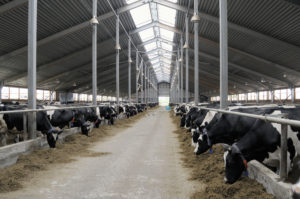Farmers and nutritionists are being warned to keep a lookout for signs of contamination in diets this winter. Sampling from Alltech and AB Vista suggests that a large proportion (46-56%) of total mixed rations, using spring/summer silage have a moderate to high mycotoxin risk. This is likely to present a range of challenges to farmers which will ultimately impact the profitability of the herd from reduced productivity and performance. It is important to be aware of the types of mycotoxins which will impact ruminants and it is just as important to be aware of the mycotoxin binder/ de-activators on the market; a simple clay binder will not remove a mycotoxin such as DON.
Mycotoxins and Endotoxins
So, what are mycotoxins and endotoxins? We understand there are many toxins which can have negative impacts on herd health and performance. More is being understood about mycotoxins, the secondary metabolites produced by the mould in the crop. Though, less is discussed about endotoxins which are produced by the bacterial death within the animals. Found in the cell wall of gram-negative bacteria, endotoxins are commonly referred to as lipopolysaccharides (LPS). They pose no threat to animal health when contained within the cell walls of the bacteria, but once the bacteria die and the LPS is released and pass into the bloodstream, where they can induce an inflammatory response.
This is an energy-consuming process and can result in numerous health issues. Mild symptoms such as increased urination can occur through to more serious issues such as death through sudden shock. LPS circulating in the blood can affect the lamina between the bones in the hoof, leading to an increase in lameness. Increasing levels of somatic cell count (SCC) in the milk can also be a clear sign that LPS could have passed into the bloodstream.
How do cows encounter Endotoxins?
Via the feed, air and the environment, cows are constantly in contact with endotoxin containing gram-negative bacteria. In healthy animals, only small quantities are absorbed through the intestine into the blood where they are then transported and detoxified in the liver. However, the number of gram-negative bacteria can be amplified when the animal is put under stress, particularly the rumen and GIT.
An example is when the rumen is acidotic. The sudden change in pH from an increase in starch digestion can cause some of the gram-negative fibre digesting microorganisms to die, which then release endotoxins into the rumen. These changes in the rumen can also lead to increased rumen wall permeability which will allow higher concentrations of endotoxins to enter the blood and overload the liver, which can lead to laminitis directly associated with the acidosis challenge.
Action against endotoxins
Control strategies to prevent endotoxin-related diseases are key to help:
• Optimising the rumen environment through the inclusion of a buffer and yeast is crucial to stabilise rumen pH and in reducing endotoxin release.
• In addition, even when the rumen is optimised, if the endotoxin burden is high then they can still have a negative effect on cow health so including a toxin binder is key.
If you any questions about mycotoxins or endotoxins, speak to your local NWF sales specialist.
Our range of Farm Pak’s have been specifically formulated to assist with a number of scenarios and situations on farms. Speak to your local NWF Sales Specialist, or call 0800 756 2787 for more information.
